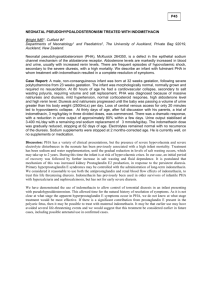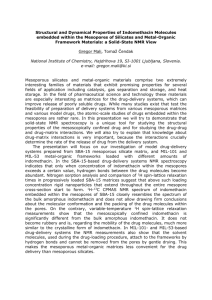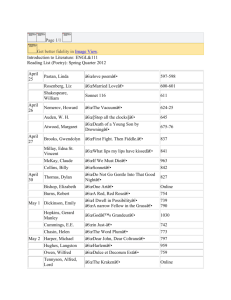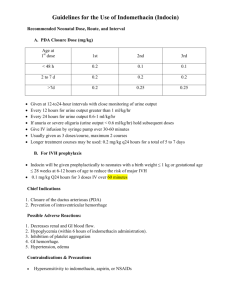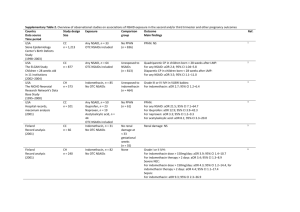Document 14258080
advertisement
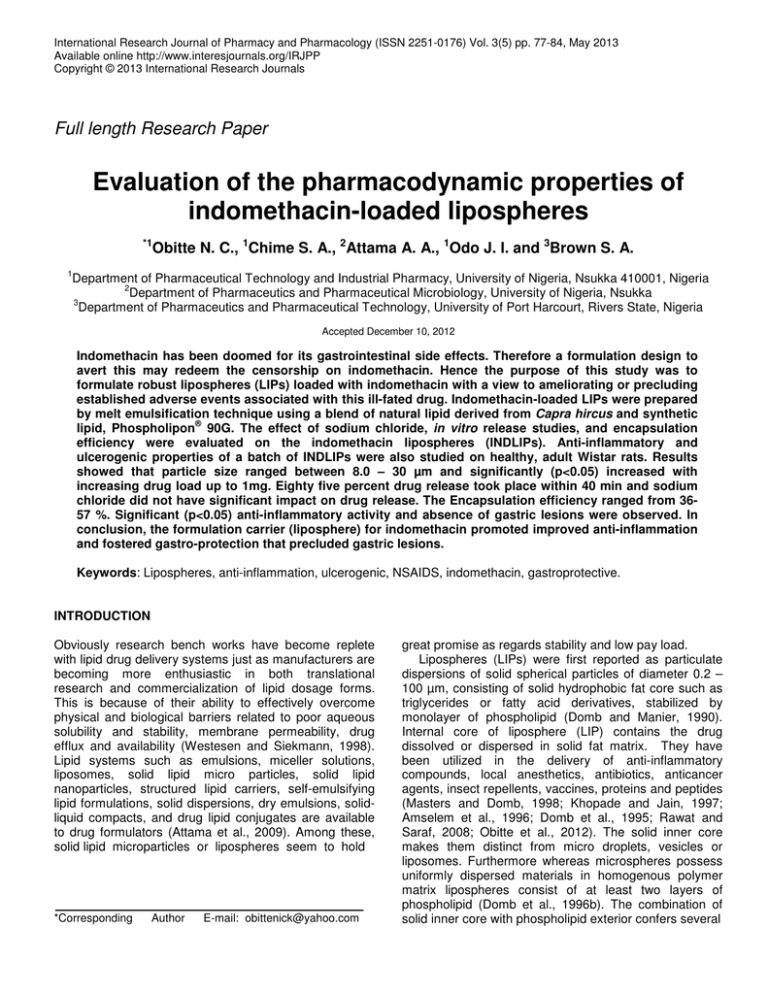
International Research Journal of Pharmacy and Pharmacology (ISSN 2251-0176) Vol. 3(5) pp. 77-84, May 2013 Available online http://www.interesjournals.org/IRJPP Copyright © 2013 International Research Journals Full length Research Paper Evaluation of the pharmacodynamic properties of indomethacin-loaded lipospheres *1 Obitte N. C., 1Chime S. A., 2Attama A. A., 1Odo J. I. and 3Brown S. A. 1 Department of Pharmaceutical Technology and Industrial Pharmacy, University of Nigeria, Nsukka 410001, Nigeria 2 Department of Pharmaceutics and Pharmaceutical Microbiology, University of Nigeria, Nsukka 3 Department of Pharmaceutics and Pharmaceutical Technology, University of Port Harcourt, Rivers State, Nigeria Accepted December 10, 2012 Indomethacin has been doomed for its gastrointestinal side effects. Therefore a formulation design to avert this may redeem the censorship on indomethacin. Hence the purpose of this study was to formulate robust lipospheres (LIPs) loaded with indomethacin with a view to ameliorating or precluding established adverse events associated with this ill-fated drug. Indomethacin-loaded LIPs were prepared by melt emulsification technique using a blend of natural lipid derived from Capra hircus and synthetic ® lipid, Phospholipon 90G. The effect of sodium chloride, in vitro release studies, and encapsulation efficiency were evaluated on the indomethacin lipospheres (INDLIPs). Anti-inflammatory and ulcerogenic properties of a batch of INDLIPs were also studied on healthy, adult Wistar rats. Results showed that particle size ranged between 8.0 – 30 µm and significantly (p<0.05) increased with increasing drug load up to 1mg. Eighty five percent drug release took place within 40 min and sodium chloride did not have significant impact on drug release. The Encapsulation efficiency ranged from 3657 %. Significant (p<0.05) anti-inflammatory activity and absence of gastric lesions were observed. In conclusion, the formulation carrier (liposphere) for indomethacin promoted improved anti-inflammation and fostered gastro-protection that precluded gastric lesions. Keywords: Lipospheres, anti-inflammation, ulcerogenic, NSAIDS, indomethacin, gastroprotective. INTRODUCTION Obviously research bench works have become replete with lipid drug delivery systems just as manufacturers are becoming more enthusiastic in both translational research and commercialization of lipid dosage forms. This is because of their ability to effectively overcome physical and biological barriers related to poor aqueous solubility and stability, membrane permeability, drug efflux and availability (Westesen and Siekmann, 1998). Lipid systems such as emulsions, miceller solutions, liposomes, solid lipid micro particles, solid lipid nanoparticles, structured lipid carriers, self-emulsifying lipid formulations, solid dispersions, dry emulsions, solidliquid compacts, and drug lipid conjugates are available to drug formulators (Attama et al., 2009). Among these, solid lipid microparticles or lipospheres seem to hold *Corresponding Author E-mail: obittenick@yahoo.com great promise as regards stability and low pay load. Lipospheres (LIPs) were first reported as particulate dispersions of solid spherical particles of diameter 0.2 – 100 µm, consisting of solid hydrophobic fat core such as triglycerides or fatty acid derivatives, stabilized by monolayer of phospholipid (Domb and Manier, 1990). Internal core of liposphere (LIP) contains the drug dissolved or dispersed in solid fat matrix. They have been utilized in the delivery of anti-inflammatory compounds, local anesthetics, antibiotics, anticancer agents, insect repellents, vaccines, proteins and peptides (Masters and Domb, 1998; Khopade and Jain, 1997; Amselem et al., 1996; Domb et al., 1995; Rawat and Saraf, 2008; Obitte et al., 2012). The solid inner core makes them distinct from micro droplets, vesicles or liposomes. Furthermore whereas microspheres possess uniformly dispersed materials in homogenous polymer matrix lipospheres consist of at least two layers of phospholipid (Domb et al., 1996b). The combination of solid inner core with phospholipid exterior confers several 78 Int. Res. J. Pharm. Pharmacol. Table 1. Quantities of ingredients for the preparation of LIPs. Batch A1 A2 A3 A4 B1 B2 B3 B4 C1 C2 LM (g) 5.0 5.0 5.0 5.0 5.0 5.0 5.0 5.0 5.0 5.0 Indomethacin (g) 0.50 0.75 1.00 1.5 0.5 0.75 1.00 1.5 - Tween 80 (ml) 2.2 2.2 2.2 2.2 2.2 2.2 2.2 2.2 2.2 2.2 Sorbitol (g) 4.0 4.0 4.0 4.0 4.0 4.0 4.0 4.0 4.0 4.0 Thiomersal (ml) 0.0025 0.0025 0.0025 0.0025 0.0025 0.0025 0.0025 0.0025 0.0025 0.0025 NaCl (g) 0.9 1.2 1.5 2.0 0.9 Water q.s 100 100 100 100 100 100 100 100 100 100 A and B: Various formulations of indomethacin-loaded LIP; C: control; LM: lipid matrix. advantages on the lipospheres compared with conventional microspheres and micro particles, including high dispersibility in an aqueous medium, and a release rate for the entrapped substance that is controlled by phospholipid coating and carrier. Lipospheres have increased stability than emulsions, vesicles and liposomes, and are more effectively dispersed than most suspension-based systems. In addition, the substance to be delivered does not have to be soluble in the vehicle since it can be dispersed in the solid carrier (Domb et al., 1996b, Rawat and Saraf, 2008). Indomethacin is a non-steroidal anti-inflammatory drug (NSAID) with prominent anti-inflammatory, analgesic and antipyretic properties, but just like other NSAIDS, it causes severe gastric ulceration. This adverse event has led to its ban in several countries in the treatment of inflammatory conditions. A formulation strategy that can circumvent this problem may change the regulatory status of this drug. Therefore the objective of this work was to assess the potentiality of lipospheres in imparting improved pharmacodynamic properties, including antiinflammation and gastroprotection, to indomethacin. Extraction and purification of goat fat The fat from Capra hircus was extracted from the adipose tissue by wet rendering (Attama et al., 2003). The adipose tissue was grated and subjected to moist heat by boiling with about half its weight of water in a water bath for 45 min. The molten fat was separated from the aqueous phase after filtering with a muslin cloth. The fat was further purified by heating a 2 % suspension of 2:1 ratio of activated charcoal and bentonite in the fat (Attama et al., 2005; Obitte et al., 2012). The fat was stored in the refrigerator until used. Preparation of lipid matrix (LM) 0 ® A hot (80 C) melt of Phospholipon 90G (a purified soy lecithin) and Capra hircus fat were mixed at a ratio of 7:3 and stirred until homogeneity was attained and it cooled into a solid mass (Obitte et al., 2012). Preparation of lipospheres MATERIALS AND METHODS Materials The following materials were used as procured from their local suppliers without further purification: Indomethacin (Medriel Pharmaceuticals, PVT ltd, India), Tween 80 (Sigma Aldrich, Seelze Germany), hydrochloric acid, sodium hydroxide, potassium dihydrogen phosphate, ® Sorbitol (Merck, Germany), Phospholipon 90G (Phospholipid GmbH, Köln, Germany), activated Charcoal (Bio–Lab, UK limited, London), thiomersal (Synochem, Germany). Capra hircus fat was obtained from a batch processed in our laboratory. All other reagents and solvents were of analytical grade. Indomethacin-loaded lipospheres were prepared by melt emulsification-hot-shear homogenization technique, using an Ultra-turrax (T25 Basic digital, Ika/Staufen, Germany) as we earlier reported (Jaspert et al., 2007) with modification (Obitte et al., 2012). 0 Indomethacin was dispersed in a hot (80 C) melt of the lipid matrix and thoroughly stirred. Into a hot 0 (70 C) aqueous phase was incorporated sorbitol, Tween 80, thiomersal and with or without NaCl, and stirred to form a solution. The lipid phase was then introduced into the aqueous phase and immediately homogenized using the Ultra turrax at 5000 rpm for 10 min. Table 1 shows the formulation ingredients and their quantities. Obitte et al. 79 Particle size determination A small dispersion of the lipospheres was placed on a microscope slide and covered with a cover slip. This was ® imaged under a Hund binocular microscope (Weltzlar, Germany) attached with a motic image analyzer (Multicam, China) at a magnification of X 100. Entrapment efficiency Aqueous dispersion of the LIP was centrifuged at 3000 rpm for 30 min and the supernatant decanted. A 0.5 g quantity of the LIPs was triturated with 20 ml of phosphate buffer and later transferred to a 100 ml volumetric flask. The flask was made up to volume with the medium, stirred for 3 min and filtered through a filter paper (Whatman No. 1). Appropriate dilutions were made and content of indomethacin assayed spectrophotometrically (Model SP6 - 450 UV/Vis Pye Unicam) at a predetermined wavelength of 278 nm. Triplicate determinations were made for all the batches. The entrapment efficiency was determined as follows: form hydration and to minimize variability in oedematous response (Winter et al., 1963). Dose of indomethacin LIPs equivalent to 0.7 mg/kg of indomethacin was administered orally to the rats. The control groups received normal saline while the reference group received pure sample of 0.7 mg/kg of indomethacin. Thirty minutes post-treatment, oedema was induced with 0.1 ml fresh undiluted egg-albumin injection into the sub planter region of the right hind paw of the rats. The volume of distilled water displaced by the treated paw was measured with plethysmometer before and at 1, 2, 3, 4, and 5 h post induction of oedema. The antiinflammatory activity was calculated at each time as percent inhibition of oedema using the equation: % inhibition = Where, Vt is the volume of oedema at corresponding time and Vo is the volume of oedema in control rats at the same time (Perez, 1996; Ahmed et al., 1993; Ajali and Okoye 2009). All experimental protocols were approved by the animal ethics committee of the faculty of pharmaceutical sciences, university of Nigeria, Nsukka. Ulcerogenic properties Drug release studies The release of indomethacin from the LIPs was studied using the USP paddle method. The dissolution medium consisted of 900 ml of freshly prepared phosphate buffer o (pH 7.4) maintained at 37 ± 0.5 C. The dialysis bag used was pretreated by soaking in the medium for 24 h prior to use. Amount of LIPs equivalent to 25 mg of indomethacin was then placed in the polycarbonate dialysis bag containing 2 ml of the dissolution medium. It was securely tied with a thermo-resistant thread and then placed in the appropriate chamber of the dissolution apparatus. The paddle was set to rotate at 50 rpm. At predetermined time intervals 5 ml samples of the dissolution medium were withdrawn, diluted appropriately and assayed spectrophotometrically (Model SP6 - 450 UV/Vis Pye Unicam) for indomethacin content. Meanwhile the dissolution medium was refreshed with equivalent 5 ml volumes. Anti-inflammatory studies Egg-albumin induced rat paw oedema method was adopted in the study. Acute inflammation was measured in terms of change in volume of the rat hind paw induced by sub planter injection of egg-albumin (Ekpendu et al., 1994; Osadebe et al., 2003). Wistar rats (150 – 180 g) of both sexes were divided into 5 rats per group. The rats were fasted for 6 h with no access to water during experiment. The deprivation of water was to ensure uni- The method described by Ajali and Okoye (2009) was used in the study. Healthy Wistar rats of both sexes (95 – 170 g) of five rats per group were fasted for 12 h. LIPs equivalent to 10 mg/kg of indomethacin was administered orally to the rats. The control group received normal saline, while the reference group received indomethacin pure sample (10 mg/kg). Five hours post treatment, the animals where sacrificed by ether anesthesia, the gastric mucosa was removed, cut along the lesser curvature and opened up to expose the mucosal surface (Ajali and Okoye, 2009). The mucosa was washed with normal saline and observed with magnifying glass x 10. The numbers of ulcers were counted and the ulcer index was determined as described by Main and Whittle (1975). All experimental protocols were approved by the animal ethics committee of the faculty of pharmaceutical sciences, university of Nigeria, Nsukka. Statistics All statistical analysis was conducted using SPSS version 13 (SPSS Inc., USA). Statistical significance was evaluated by ANOVA at( p<0.05). Data were represented as Mean ± standard deviation RESULTS AND DISCUSSION Particle size The photomicrographs presented in Figures 1-4 show the 80 Int. Res. J. Pharm. Pharmacol. Figure 1. Photomicrograph of batch A1 lipospheres Figure 2. Photomicrograph of batch A3 lipospheres Figure 3. Photomicrograph of batch B1 lipospheres. Obitte et al. 81 Figure 4. Photomicrograph of batch B1 lipospheres. Table 2. Properties of indomethacin-loaded lipospheres. Batch A1 A2 A3 A4 B1 B2 B3 B4 C1 C2 PS (µm ± SD) 12.50 ± 2.10 19.84 ± 1.17 30.00 ± 2.11 8.30 ± 2.57 10.61 ± 2.32 15.63 ± 2.47 22.5 ± 1.19 12.5 ± 1.12 5.94 ± 0.87 8.50 ± 2.56 a EE (%) 54 40 37 36 57 48 39 38 - T50 (min) 44 36 35 33 44 37 31 31 - T85 (min) 49 48 48 46 49 43 43 41 - a n = 100; SD: Standard deviation; PS: Particle size; EE: Encapsulation efficiency; A1 – A4: Indomethacin-loaded lipospheres in the absence of sodium chloride; B1 – B4:indomethacin-loaded lipospheres containing different ratios of sodium chloride; C1 – C2:lipospheres containing no drug. sphericalness of the indomethacin-loaded LIPs while Table 2 shows that particle size was affected by the nature of formulation excipients used and amount/ratio of drug incorporated. In the entire batches particle size significantly (p<0.05) increased with increasing drug load up to 1mg. Further increase in drug load to 1.5 mg did not result to corresponding increase in particle size. Similarly the presence of NaCl caused a significant (p<0.05) reduction in particle size. Particle size has been reported to be a function of either one or more of the following: formulation excipients, degree of homogenisation, homogenisation pressure, rate of particle size growth, crystalline habit of the particle etc (Attama et al., 2009). The observed particle size increase which depended on drug load had similarly been reported by other workers (Barakat et al., 2006; Joseph et al., 2002). It was discovered that 1 g drug loading marked the maximum drug concentration the lipid matrix could accommodate. Beyond this concentration the LIPs experienced size reduction. Lipid matrix disruption caused by drug overload may explain this observation. Furthermore particle size reduction caused by NaCl may be attributed to interaction between the hydrophilic polar heads of the phospholipid and the sodium chloride in the aqueous phase. Increased membrane potential and permeability by sodium chloride promoted aqueous diffusion which probably increased the susceptibility of the particles to disruption and subsequent reduction (Nwafor and Coakley, 2003; Obitte et al., 2012). 82 Int. Res. J. Pharm. Pharmacol. Figure 5. Graph of % Amount of drug released vs Time for Indomethacin-loaded liposheres without NaCl. Figure 6. Graph of % Amount of drug released vs Time for Indomethacin-loaded liposheres without NaCl. Encapsulation efficiency (EE %) Table 2 shows the EE % values of 36-54 % in the absence of NaCl. On the other hand batches containing NaCl had values within the range of 38-57%. They were derived from drug content results (data not shown). This reveals that NaCl did not seem to have any significant effect on the efficiency of drug encapsulation. Highest EE % values appeared to correspond with least drug loading, the reverse being the case with batches with the lowest EE % values. The matrix had a limit of drug encapsulation which did not proceed beyond saturation. Drug release from indomethacin-loaded lipospheres The drug release profiles (Figures 5-6) and T50/ T85 values (Table 2) are indicative of progressive drug Obitte et al. 83 Table 3. Anti-inflammatory properties of indomethacin-loaded lipospheres. b Batch B1 D (Ref.) E (Con.) Paw volume oedema (ml ± SD) and percentage inhibition of oedema (%) 0.5 h 1h 2h 3h 4h 5h 1.16 ± 0.11* 1.13 ± 0.17* 0.90 ± 0.09* 0.83 ± 0.07* 0.82 ± 0.12* 0.80 ± 0.20* (27.0) (28.0) (41.9) (45.4) (45.3) (47.0) 1.40 ± 0.05* 1.30 ± 0.14* 1.10 ± 0.11* 0.96 ± 0.23* 0.92 ± 0.17* 0.83 ± 0.12* (12.5) (17.2) (29.0) (36.8) (38.0) (45.0) 1.57 ± 0.17 1.55 ± 0.09 1.52 ± 0.11 1.50 ± 0.10 1.60 ± 0.10 1.50 ± 0.07 *Reduction in oedema significant at p < 0.05 compared to control. Values of oedema shown are mean ± SD, bn = 5; Values in parenthesis are percent inhibition of oedema calculated relative to control. B1: indomethacin-loaded LIPs; D: indomethacin pure sample; E: normal saline. Table 4. Ulcerogenic properties. Batch B1 D (Ref.) E (Con.) Ulcer index (Mean ± SD) 0.00 ± 0.00* 14.00 ± 1.12* 0.00 ± 0.00 a *Reduction in oedema significant at p < 0.05 compared to control. an = 5; B1: indomethacin-loaded LIPs; D:Pure indomethacin powder; E: normal saline. release that attained maximum values in less than 1 h. A biphasic release pattern was observed with the formulations. In the first phase batches A1-A4 released 20 % of drug within 25 min; in the second phase about 80 % of drug witnessed faster release within approximately the same duration. The same observation held for batches B1-B4. In the presence or absence of NaCl batches A1 and B1 with the highest EE % were noted to have slightly delayed release than the rest of the batches. Apparently NaCl had no significant impact on drug release. On the whole, 85 % of drug release was observed within 40 min against the backdrop of 30 min documented for immediate release formulations without solubility challenges (Shohin et al., 2010). However given the poor solubility of indomethacin, the T85 of about 40 min reported in this work should be a good performance. The acidic pH characteristics of indomethacin may have engendered improved dissolution in the presence alkaline pH. Anti-inflammatory properties The result of anti-inflammatory studies of indomethacinloaded lipospheres is presented in Table 3. The Test and Reference batches achieved significant (p<0.05) edema nd reduction at the 2 h. However, the Test (batch B1) recorded significantly higher (p<0.05) anti-inflammatory rd th effect than the Reference. Between the 3 and 4 h there was no significant change in anti-inflammation. The phospholipid component of the LIPs has a polar head and lipophilic tail; the latter provides a mileu that may solubilize poorly soluble drugs. This was probably the case with phosphatidylcholine and our candidate poorly soluble drug, indomethacin. Also, phosphatidylcholine has been reported to improve the lymphatic transport of some drugs (Trevaskis et al., 2006). This alternative transport route avoids first pass metabolism. These unique characteristics of this lipid may have contributed to the significant anti-inflammatory activity of indomethacin. It is interesting to note that previous workers have earlier reported improvement on the therapeutic effect of some NSAIDS formulated with phosphatidylcholine compared to the powdered drug (Bhupinderjit et al., 1999). Ulcerogenic properties The ulcerogenic studies presented in Table 4 show that indomethacin-loaded LIPs exhibited good gastroprotective properties. There was complete inhibition of gastric lesions in animals that received indomethacinloaded LIPs. However, the reference group showed many lesions in the gastric mucosa of the animals. The absence of lesions with the LIPs is attributed to the gastroprotective potential of Phosphatidylcholine in the formulation. Indomethacin’s anti-inflammatory property is due to the inhibition of COX -2 which causes tissue inflammation. Unfortunately it also inhibits COX-1 84 Int. Res. J. Pharm. Pharmacol. responsible for the production of prostaglandin, the gastro protective agents, and consequently results to gastrointestinal problems (Bhupinderjit et al., 1999). This was why indomethacin-treated animals were inundated with lesions. Endogenous Phospholipids produced by gastric surface mucus or exogenous ones stimulate COX-1 to synthesize prostaglandin which in turn imparts hydrophobic characteristic to the mucosal surface of the gastrointestinal tract (Fricker et al., 2010; Obitte et al., 2012; Parnham and Leyek, 1988). This explains the absence of lesions in the indomethacin-loaded LIPs. CONCLUSION The lipospheres not only allowed 85% drug release in less than 50 min but demonstrated superior antiinflammatory property and gastroprotective effect. This is hope-raising for indomethacin manufacturers and suggests that indomethacin could be sent back to the shelf using liposphere approach. ACKNOWLEDGEMENT The authors acknowledge the gift sample of Phospholipon 90G from Phospholipid GmbH, Germany. REFERENCES Ahmed MM, Qureshi S, Al-bekairi AM, Shah AH, Rao RM (1993). Fitoterapia. 64:359-362. Ajali U, Okoye FBC (2009). Int. J. App. Res. Prod. 2:(1)27-32. Amselem S, Alving CR, Domb AJ (1996). Drgs. Pharm. Sci. 77:149168. Attama AA, Nkemnele MO (2005). Int. J. Pharm. 304(2005):4–10. Attama AA, Nzekwe IT, Nnamani PO, Adikwu MU, Onugu CO (2003). Int. J. Pharm. 262: 23 – 28. Attama AA, Okafor CE, Builders PF, Okorie O (2009). J. Drug Deliv. 16:448–616. Barakat SN, Yassin EB (2006). Drug Deliv. 13: 95 – 104. Bhupinderjit SA, Jim JR, Sudershan KS, Lenard ML (1999). The Amer. J. Gastroent. 94:1818-1822. Domb AJ, Bergelson L, Amselem S (1996b). Lipospheres for controlled delivery of substances. In Benita S. (ed), microencapsulation, method and industrial applications. Marcel Dekker Inc. NY. 337- 410. Domb AJ, Manier M (1990). Lipospheres for controlled delivery of pharmaceuticals, pesticides, fertilizer. Nova pharmaceutical corporation 90-US6519 (9107171). 79:8-11. Domb AJ, Marlinsky A, Maniar M, Teomim L (1995). J. AM. Mosqu. control Assoc. 11:29- 34. Ekpendu JO, Akah PA, Adesomoju AA, Okogun JI (1994). Int. J. Pharmacog. 32:991-2196. Fricker G, Kromp T, Wendel A, Blume A, Zirkel J, Rebmann H, Zetzar C, Quinkert R, Martin F, Muller-Goymann C (2010). Pharm. Res. 27:1469-1486. Friedrich I, Muller-Goymann CC (2003). Eur. J. Pharm. Biopharm. 56:111-119. Jaspert S, Bertholet P, Piel G, Dogne JM, Delattre L, Evrard B (2007). Eur. J. Pharm. Biopharm. 65: 47 – 56. Joseph N, Lakshims, Jayakrishnan A (2002). J. Control. Rel. 79:71–79. Joshi NH, Shah N (2008). Review of lipids in pharmaceutical drug delivery system, part I. American Pharmaceutical Review. A Russel Publishing Publication. 1. Khopade AJ, Jain NK (1997). Pharmizie. 52:165-166. Main IHM, Whittle NB (Jnr) (1975). Brit. J. Pharmol. 53:217–224. Masters DB, Domb AJ (1998). Pharm. Res. 15:1038-1045. Nwafor A, Coakley WT (2003). Afri. J. Biomed. Res. 6:95-100. Obitte NC, Chime SA, Magaret AA, Attama AA, Onyishi IV, Brown SA (2012). Afr. J. Pharm. Pharm. 6(30):2309-2317. Osadebe PO, Okoye FBC (2003). J. Ethnopharm. 89:19-24. Parnham MJ, Leyck S (1988). Drugs. Fut. 13:324-325. Perez G.R.M. (1996). Phytomedicine. 3:163-164. Rawat M, Saraf S (2008). Int. J. Pharm. Sci. Nanotech. 1(3):207-214. Shohin IE, Yamenskaya GF, Malashenko EA (2010). Diss. Tech. Aug. 20-22. Trevaskis NL, Porter CJH, Charman WN (2006). The lymph lipid precursor pool is a key determinant of intestinal lymphatic drug transport. J. Pharmacol. Exp. Ther. 316:881-91. Westesen K, Siekmann B (1998). U.S Patent 5785 976. Winter EA, Risley EA, Nuss GU (1963). J. Pharm. Exp. 141:367376.
